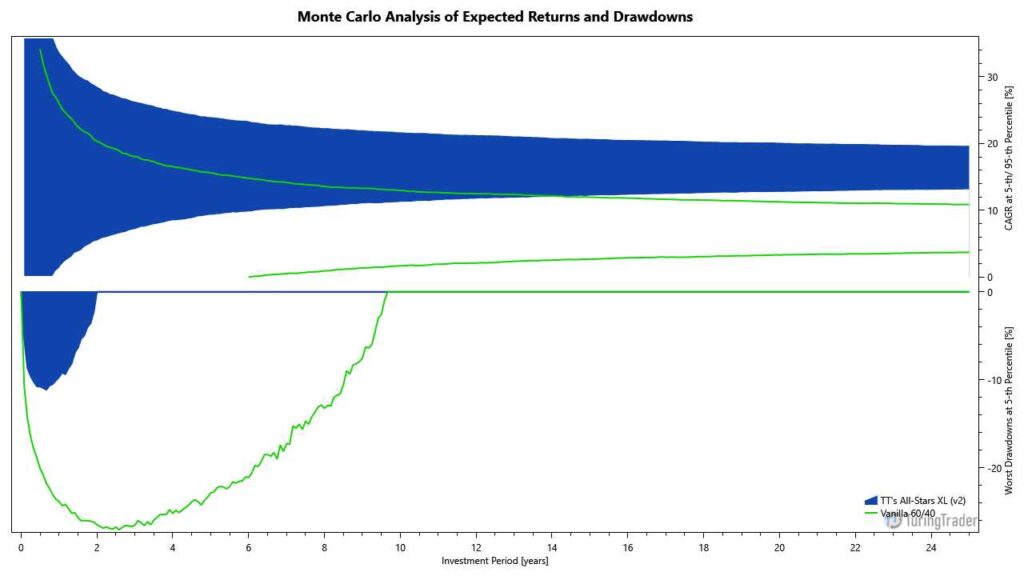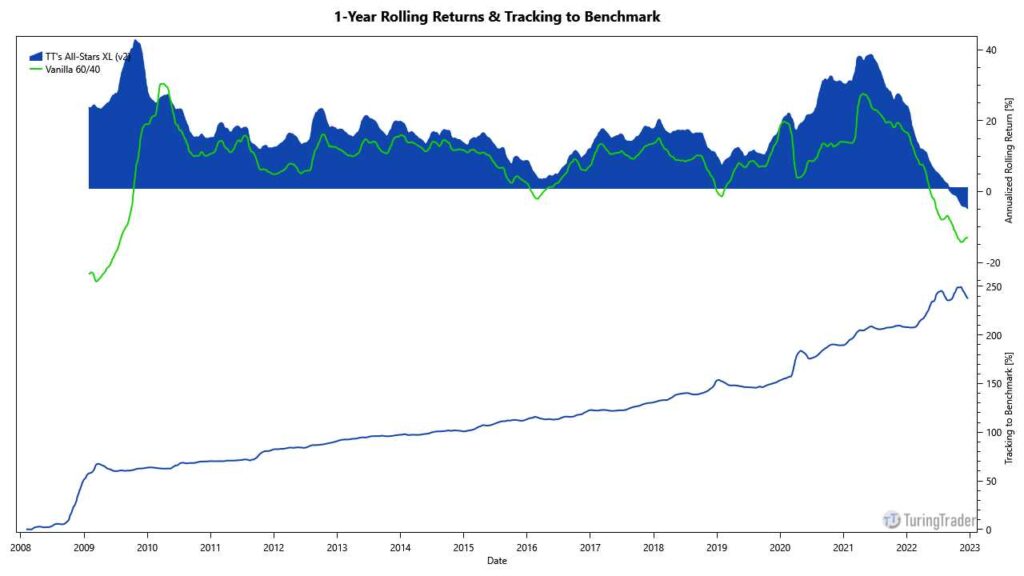Summary
- Objective: aggressive growth
- Type: momentum strategy
- Invests in: individual stocks from the S&P 500
- Rebalancing schedule: weekly
- Taxation: 90% short-term capital gains
- Minimum account size: $15,000
Laurens Bensdorp is the founder and CEO of Trading Mastery School and has been beating the market since 2007. Bensdorp published the Weekly Rotation strategy in his book The 30-Minute Stock Trader, released in 2017.
Bensdorp’s Weekly Rotation aims to beat the S&P 500 with lower drawdowns in bear markets. To achieve this objective, the strategy trades all S&P 500 constituents with a momentum approach: stocks are ranked by their absolute momentum, with additional safeguards preventing the strategy from taking positions in overall market downturns. As a result, the strategy invests mostly in high-flying blue-chip stocks. Investors can expect constant positive media coverage for their holdings, which helps building trust in the strategy and following it without second-guessing.
The strategy rotates and rebalances once per week, leading to modest maintenance requirements.
Performance
This table shows the portfolio’s key performance metrics over the course of the simulation:
The following chart shows the portfolio’s historical performance and drawdowns, compared to their benchmark, throughout the simulation:
This chart shows the portfolio’s annual returns:
The following charts show the Monte-Carlo simulation of returns and drawdowns, the portfolios 12-months rolling returns, and how the portfolio is tracking to its benchmark:


Asset Allocation
The portfolio last required rebalancing after the exchanges closed on @last-rebal@. Due to fluctuations in asset prices, the exact allocations vary daily, even when no rebalancing occurred. The current asset allocation is as follows:
Sign up for our FREE Basic membership to see the asset allocation.
Sign up for our FREE 14-day trial to see the asset allocation.
Strategy Rules
The operation of Weekly Rotation can be summarized as follows:
- trade all stocks from the S&P 500 index
- rebalance once per week (over the weekend)
- only hold positions while the S&P 500 is above the 200-day moving average band, drawn 2% below the SMA
- disqualify stocks with a 3-day RSI exceeding 50
- pick the 10 stocks with the highest 200-day momentum
- assign 10% of capital to each position
Of special interest are the the additional filters. One aims to avoid entering stocks which are currently overbought, regardless of their momentum. The other rule inhibits taking new positions while the S&P 500 is in an overall downtrend. For full details, we recommend reading Bensdorp’s book The 30-Minute Stock Trader. Also, we suggest checking the C# source code in the TuringTrader.org open-source repository.
We like the idea of delaying new entries until individual stocks are at least no longer overbought a lot as it seemingly bridges the gap between momentum and mean-reversion. Unfortunately, we don’t see this added complexity pay off. We suspect that Bensdorp’s strategies are overfitted; read our book review for some more in-depth analysis.
Diversification
Bensdorp’s strategy holds 10 U.S. large-cap stocks. With that, the strategy is reasonably well diversified within the stock market. However, this represents only a single asset class, resulting in a tail risk similar to that of holding the S&P 500 index. Investors should consider pairing the Weekly Rotation with other portfolios and asset classes for improved diversification.
Returns & Volatility
The Weekly Rotation has handled the 2008 recession very well. Further, it held its value in the challenging markets of 2015. However, we notice several sharp drawdowns in mid-2011, early 2014, mid-2015, and late 2018, where Bensdorp’s strategy amplified the S&P 500’s volatility. We believe this to be a combination of momentum breaking down, and the strategy not considering correlation or volatility of its assets.
At least over the last economic cycle Weekly Rotation has not met Bendsorp’s objective. While the strategy does have some upside to the S&P 500 it is nowhere close to the proclaimed doubled returns.
The Monte-Carlo simulation confirms these observations. Bensdorp’s strategy provides only little upside to the stock market index, but does provide a meaningful reduction in downside. Further, the Monte-Carlo simulation reveals that there is only little confidence in the simulation’s low maximum drawdown.
Account & Tax Considerations
Just like the name suggests, Bensdorp’s strategy trades weekly and frequently triggers taxable events. The chart above shows that the strategy holds most positions for less than 6 months. However, the strategy’s strongest picks with returns of 100% or more will likely qualify for long-term treatment of their capital gains.
Therefore, Weekly Rotation will work best in tax-deferred accounts. In taxable accounts, the strategy probably adds only little value.
Weekly Rotation invests in 10 high-flying and potentially expensive stocks. To do so, it requires an account size of no less than $15,000.
